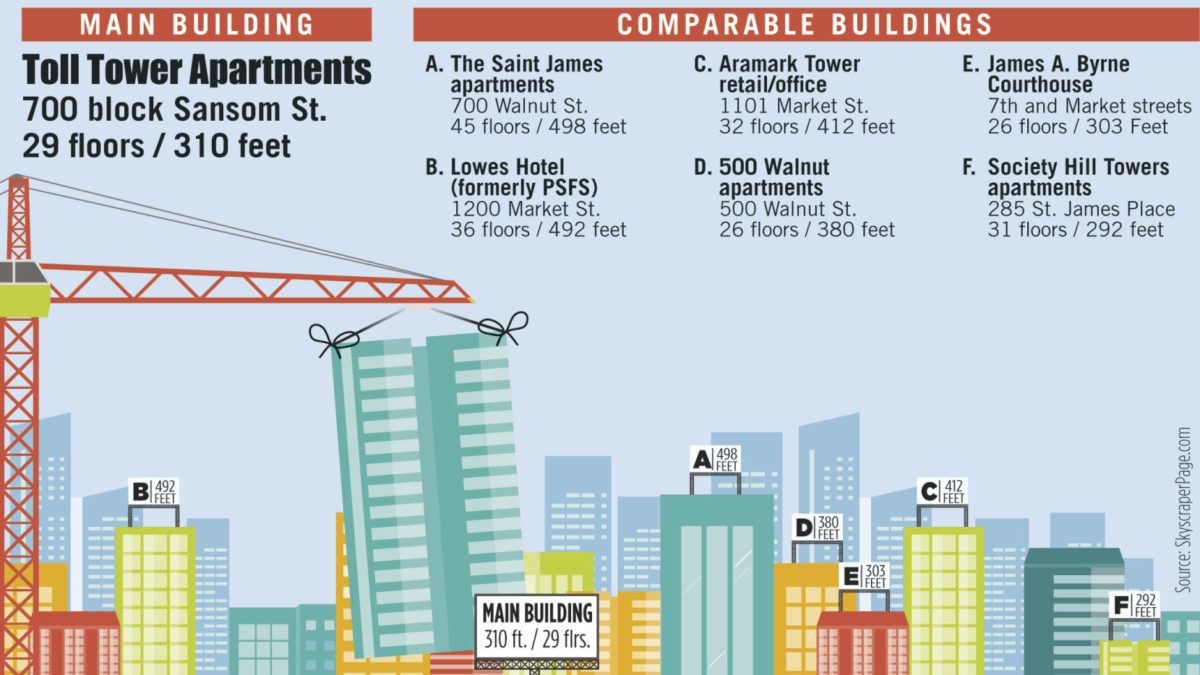It looks like the end of the line for Maryann Ritter and the other tenants of Philadelphia’s venerable Jewelers’ Row, who have been fighting plans by the developer Toll Brothers to demolish five historic buildings in the city section to make way for a 24-story apartment tower.
On April 4, Ritter and the other occupants received eviction notices to leave the buildings — which don’t have a local historic designation — by May 31, bringing to an apparent end their three-year fight against the development in the courts and with the City of Philadelphia.
The notices were delivered on the same day the Kenney Administration announced it was stepping up its efforts to protect Philadelphia’s historic buildings, which are being lost at an increasing rate as developers seek land to feed the city’s current construction boom.
The irony of the timing was not lost on Ritter, who has run her business on Jewelers’ Row — one of the nation’s oldest jewelry districts — for 47 years, including 19 at her current location, the ground floor of 704 Sansom Street.
“It pretty much throws my whole life upside down,” Ritter, 68, said in an interview with PW. “I really thought I would be ending my career here. There’s not really any place to move, and when you do find places to move, the rents are outrageously high.”
But she says she loves her job, has no plans to retire and will continue to look for another place to run the business.
If it’s too late to prevent Jewelers’ Row from falling to the wrecking ball, preservationists are heartened by the city’s new efforts to protect the historic fabric in one of America’s oldest cities, following the recommendations of a mayoral task force.
“The task force represents the most ambitious effort to update and reform preservation laws and regulations that any mayor has ever done,” said Paul Steinke, executive director of the Preservation Alliance for Greater Philadelphia, a leading advocate for the protection of historic buildings.
Historic properties are now being threatened by the building boom that comes with economic vitality rather than the stagnation or decline that characterized the city when manufacturing began to move out during the mid-20th century, he said.
In 2018, developers added 2,810 housing units in Greater Center City—the area bounded by the rivers, Girard Avenue and Tasker Street—according to the economic development organization Center City District. It was the biggest increase in the city’s stock of apartments and condos since CCD started tracking the market 20 years ago. Another 3,000 units are under construction or recently completed, the group said in a February report.
Steinke said it’s not possible to quantify the number of historic buildings that have been lost in the development boom because there has been no city-wide inventory. But he said the number of demolitions has been rising and is now at a 15-year high. He estimated that around 1,000 properties will be named in a new index of historic properties that the City plans to compile as part of the new initiative.
The City also aims to make it easier to nominate buildings for historic designation, and is backing legislation that would provide incentives for developers to adapt and reuse buildings rather than just tear them down.
Some other proposals will need legislative approval from City Council. The measures, to be introduced by Councilman Mark Squilla, include reducing parking requirements — a challenge for any developer — at historic buildings, and allowing new dwelling units in historic properties so that the owners can get more income to help maintain the building.
From one developer’s point of view, such changes won’t do much to encourage preservation, especially when compared with historic tax credits from federal or state governments.
“Are they helpful? Yes,” said Eric Blumenfeld, developer of the Divine Lorraine Hotel, a historic apartment building on North Broad Street, and the recently reopened Metropolitan Opera House a few blocks away. “But I don’t see them as dramatic enough to change the tide.”
What’s really needed, Blumenfeld said, is the restoration of the federal historic tax credit that was cut by the Trump tax reforms, and for Pennsylvania to beef up its own tax credit which Blumenfeld said is too small to significantly increase preservation.
But Carl Dranoff, developer of historic properties including Locust on the Park in the Fitler Square neighborhood, and the Packard Building on Broad Street, said the “carrots” that would be offered to developers under the city’s plan are likely to spur them to preserve more buildings.
“I think we have a blueprint that we didn’t have before, and it was very thoughtfully balanced,” Dranoff said. “The whole thrust of it is, ‘Let’s not make preservation a burden so that it reduces the value of properties. Let’s make it an incentive so that you can preserve the properties and make them financially feasible.’”
The initiatives follow the recommendations of the Philadelphia Historic Preservation Task Force, a panel whose 33 members included developers, preservationists, architects and community members, set up by Mayor Kenney in April 2017.
Although Philadelphia has the second-most pre-1945 buildings of any American city, only 2.2 percent of them are protected by local historic designation, about half the national rate, according to the Task Force.
Among the historic buildings that now have a better chance of surviving is the Esslinger Brewery at the intersection of Ridge Avenue and 10th and Callowhill Streets just north of Chinatown. The jumble of red-brick buildings have made beer and soap at various times since the 1860s and are now occupied by a manufacturer of janitorial supplies.
The buildings may not win any awards for architectural flair or curb appeal, but they are worth preserving, advocates say, because they may represent the city’s longest continuous industrial occupancy in one building, and because the brewery was one of the few to survive prohibition in Philadelphia.
In May 2018, the building was added to the Philadelphia Register of Historic Places, which requires the City Historical Commission to approve any plan to demolish a historic site, and sets high standards for any developer seeking to justify a plan to take a building down.
But it was too late for the Society Hill Playhouse, a fixture on the city’s theater scene from 1959 until it was demolished in 2016 to make way for a new apartment building on South 8th Street. The same goes for the Christian Street Baptist Church that was built in 1890 and demolished in July 2018.
Such losses are helping to drive the new initiative, along with the recognition that Philadelphia’s history sets it apart from many other cities, Steinke said.
“This is a 300-year-old city with architectural history and legacy second to none,” he said. “We have something really special here in Philadelphia that’s worth understanding and worth protecting.”
TWITTER: @JONAHURDLE




